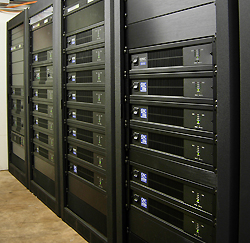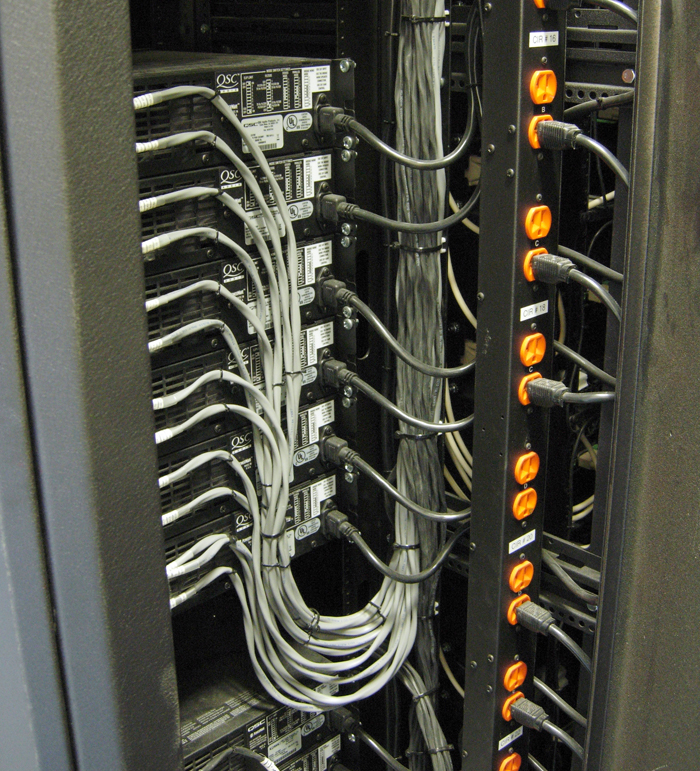
Time is money – direct drive. Broadly speaking, up until about 10 years ago, a distributed system was most often serviced by a low impedance amplifier coupled with a large output transformer.
Since then, in order to save space and weight, some manufacturers have offered special “high voltage” amplifier versions that are specifically designed to directly drive a 70-volt or sometimes 100-volt line without the use of an output transformer.
Although it may not be instantly obvious, any amplifier that can drive at least 625 watts at 8 ohms can also directly drive a 70-volt line – and if you could bridge that amp you could most likely drive the 100-volt case as well.
While it’s not common to find a true “direct drive” amplifier that delivers low impedance, 70-volt and 100-volt drive from a single channel or perhaps from a bridged pair of channels, true direct drive products—that is, having a single amplifier that can do the job without math, without transformers, and without exception—can significantly reduce the number of product choices required, often by as much as 50 percent.
Additionally, amplification products with true direct drive offer much more flexibility when on site. No longer does a change order that includes one more zone of distributed speaker mean another specialized amplifier…just an unused direct drive channel.
Time is money – flexibility. As we have shown, the industry trends and manufacturers are moving toward fewer and fewer different SKUs. This tends to make both the integrators and the manufacturers’ jobs easier.
That said, there is one axis of flexibility that has always been fixed across the amplifier marketplace: power. Power has generally be available in finite, discrete steps. Thus it was up to the integrator/system specifier/designer to know a product line and a potential job well enough to know which amplifier would most appropriately deliver the required power.
The only flexibility within a given amplifier power point would be to bridge a pair of channels in order to gain more voltage swing – and power delivered into higher impedance loads.
There are two manufacturers who have taken this issue on. One manufacturer (Bose Professional) does allow for a more flexible way of configuring a given power amplifier, but effectively restricts this flexibility to within its own system line. The other manufacturer, QSC, has come up with a method of reducing the number of amplifiers needed to address a variety of power points.
The company calls this method (or technology) FAST, an acronym for Flexible Amplifier Summing Technology. Effectively this technology allows amplifiers channels to be configured in both bridge mode and in parallel mode. For example a traditional 4-channel amplifier might allow you to bridge channels 1 and 2 and/or bridge channels 3 and 4.
FAST technology opens up a wider range of options. For example, channels can be bridged (doubling the available voltage), or placed in parallel (doubling the available current). These options are not limited to a pair of channels. This means that amplifiers equipped with FAST technology can be deployed as a 4-channel, 3-channel, 2-channel, or even a mono-block amplifier. Basically this means that no matter the load impedance, from 100-volt distributed all the way down to 1 ohm, a single amplifier can be configured to deliver maximum power. Editor’s Note: Go here to find out more about FAST technology (pdf).
Let’s examine a possible configuration to better understand this process. Based on the technical data supplied by QSC, an amplifier with FAST could be configured such that the first three channels (A,B,C) are placed in parallel with each other and connected to a 2-ohm concert subwoofer array and the remaining channel is connected to a distributed 100-volt line. That subwoofer will get about three-quarters (3/4) of the total output power, while the distributed line still has over 1000 watts of power available.
Although confusing at first blush, there is a method to the madness. Rather than offering dozens of power points, QSC only offers three power points. Now the option to configure each amplifier in the most appropriate way is accessible with the only trade-off being the available number of channels. The theory is that the integrator only has to reach for a small handful of tools and can configure each to drive whatever power/impedance combination necessary.

